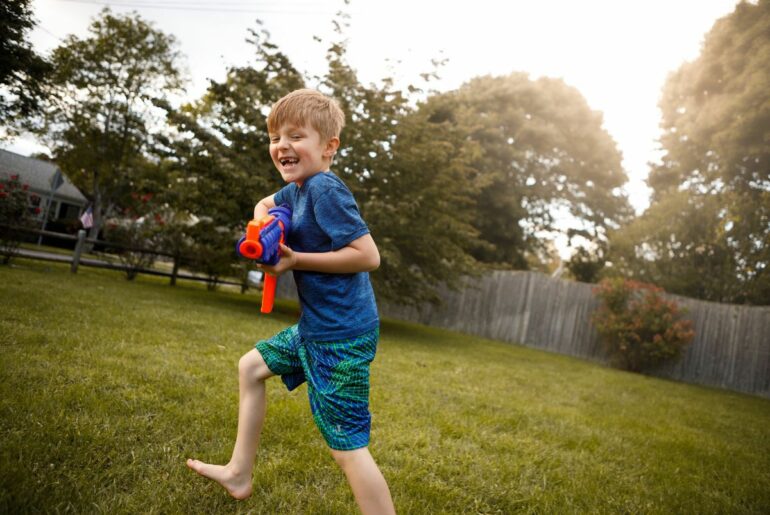Recent mass shootings such as the tragedy at Robb Elementary School in Uvalde, Texas have built increasing urgency in the national conversation around gun violence. Between shootings constantly reported in the news and the zero-tolerance policies many schools have towards gun play of any kind, it’s no wonder toy guns are less popular than ever.
Research tells us, however, that there is not actually a direct connection between playing with toy guns as a child and committing gun violence later in life. Toy guns themselves do not encourage violent behavior, but parents should keep an eye on the way their kids play with toy guns, which may indicate potential warning signs. As Dr. Deborah J. Cohan of the University of South Carolina-Beaufort explains:
“There is not an easy causal path between pretend guns and violence in children. The most important thing is to evaluate the accompanying behavior to determine how aggressive, hostile, and hurtful it is. We should be concerned if we see children unable to separate reality and fantasy, where the lines become so blurry that they rely on aggressive and bullying behavior to resolve real-world conflict and to make their voices heard. It is all about context.”
Why kids play with toy guns
Although many parents are uncomfortable with their kids engaging in imaginary gun play — and it can certainly appear violent on the surface — experts say that there are developmental reasons why kids might gravitate towards this type of play.
To most children, guns symbolize power, authority, and control, but not necessarily violence. Toy guns give kids a safe outlet to explore these concepts, and help them feel confident doing so because they’re at a distance from the pretend “danger” — much like using the powers in a fairy wand. As child development expert Jeff A. Johnson puts it, “A child crawling on his belly across the yard holding a stick-gun may be processing a pretend death and heroically pursuing a powerful enemy he will confront and defeat. As casual observers, this kind of play looks violent and can make us adults feel icky inside, but the learning is rich and valuable.”
Kids may also be interested in toy guns because of their association with adults they see as important or authoritative like police officers or military personnel. They can safely explore boundaries and power dynamics with imaginary gun play, as long as adults introduce some safety precautions and rules to follow.
Setting boundaries for safe toy gun play
The fact is, if a child is determined to play with toy guns, they will find a way to do so whether they’re banned or not. Kids have big imaginations and will turn anything from sticks to their own fingers into toy guns if they have the drive to engage in that type of play. Banning imaginary gun play may only serve to give guns more power and allure in their minds.
Parents who choose to let their kids play with toy guns should set some rules and boundaries to create a safe environment for everyone involved. Here are some examples of healthy boundaries around imaginary gun play —
- Safety first: Kids should never physically hurt themselves or others during any type of play. Make sure any play weapons are as safe as possible, in good condition, and that all usual safety precautions are being followed. Some toy guns are safer than others, so young kids shouldn’t play with BB or pellet guns, while plastic or foam toy guns might be a safer option.
- Real vs. fake: Make sure they understand the difference between real and toy guns. It’s especially important to emphasize how they can look different, so that if your child ever encounters a real gun they’ll know to leave it alone and tell an adult. However, they should also be aware that toy guns can sometimes look quite real, and real guns can sometimes be brightly colored, made of plastic, or otherwise look like toys — so kids should feel comfortable alerting an adult any time they encounter a weapon they’re not familiar with.
- Appropriate targets: Set parameters around what is and isn’t an appropriate target. You might tell them they can’t point their toy guns at people’s faces, people who aren’t playing with them, pets, etc.
- Emphasize consent: Kids playing with toy guns should learn how to ask others for consent to engage in that type of play with them. They can say something like, “I want to play with my toy gun, do you want to play with me?” They should also ask if the other person minds having it pointed at them.
- Appropriate places to play: Depending on your family and where you live, you may want to establish some parameters around where imaginary gun play is allowed. It’s a harsh reality that Black and brown kids, through no fault of their own, can be unfairly perceived as dangerous when engaged in this type of playtime — and the police killing of 12-year-old Tamir Rice was a chilling example of how innocent toy gun play can endanger kids of color in ways that white children don’t typically experience. You might make a rule that toy gun play is only allowed inside your house or in the backyard, or inside the homes of friends who have consented to play along.
- Look for red flags: While toy guns themselves aren’t linked with violent behavior, you may be able to see warning signs during toy gun play that you should share with your pediatrician. For example, regularly “accidentally” hurting other people or animals, lack of remorse or empathy, or excessive aggression might be cause for concern.
And as always, it’s extremely important for families to have discussions about gun safety with their children. Whether or not you have a real gun in the home, it’s still possible for kids to encounter guns at other peoples’ houses or out in the world. Our guide to gun safety for parents can help foster some age-appropriate conversations about staying safe from gun violence.







